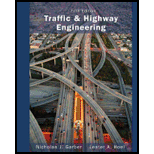
Concept explainers
The central angles and the corresponding chord lengthsfor a compound curve which connects two tangents.
Answer to Problem 17P
For the first curve central angle and chord length is shown in table below,
| Station | Deflection angle | Chord length |
| | | |
| | | |
| | | |
| | | |
| | | |
| | | |
| | | |
For the second curve central angle and chord length is shown in table below,
| Station | Deflection angle | Chord length |
| | | |
| | | |
| | | |
| | | |
Explanation of Solution
Given information:
Intersection angle
Angle of first deflection curve
Radius of first curve
Radius of second curve
PCC station
Calculation:
Deflection for second curve is given by,
Tangent length of first curve is given by,
Similarly tangent length for second curve is given by,
Length of first curve is given by,
Length of second curve is given by,
Station of first curve at PC is given by,
The station of PCis the point of curve according to the standards of AASHTOit is calculated by dividing the station when it reaches above
Station at point of tangency is given by,
For the first curve calculate degree of first curve is given by,
Deflection angle for first full station is given by,
Deflection angle is given by,
For the first curve chord length is given by,
Deflection angle for last full station is given by,
For the first curve central angle and chord length is shown in table below,
| Station | Deflection angle | Chord length |
| | | |
| | | |
| | | |
| | | |
| | | |
| | | |
| | | |
For the second curve calculate degree of second curve is given by,
Deflection angle for first full station is given by,
Deflection angle is given by,
For the second curve chord length is given by,
Deflection angle for last full station is given by,
For the second curve central angle and chord length is shown in table below,
| Station | Deflection angle | Chord length |
| | | |
| | | |
| | | |
| | | |
Want to see more full solutions like this?
Chapter 15 Solutions
Traffic And Highway Engineering
- Please answer the two questions in detail and as best as you can. Please ensure it is 100% done by human, please do not use AI or chatgpt.arrow_forwardPlease answer the two questions in detail and as best as you can. Please ensure it is 100% done by human, please do not use AI or chatgpt.arrow_forwardPlease answer the two questions in detail and as best as you can. Please ensure it is 100% done by human, please do not use AI or chatgpt.arrow_forward
- Please provide a handwritten solution to the questionarrow_forwardkevin.w.wickline@wv.govarrow_forwardWhat is the value of the influence line for the bending moment around B at B for the beam shown? Determine the influence line ordinates at 3-m intervals. Select the reaction at support C to be the redundant. A a. 1.875 kN 6 m b. 0.688 kN c. 2.25 kN > d. 0.313 KN B -12 m- El = constant Carrow_forward
- H.W: An activated sludge process operates under the following data: Q=0.21 m³/s, S.- 250 mg/l, S-6.2 mg/l, MLVSS (X) = 3500 mg/1, 0= 10 days Return sludge concentration (X)= 10000 mg/l, Y=0.5, K₁ =0.06 d', volatile super solid represent 80% of SS, Find: 1- Treatment efficiency 2- Reactor volume 3- Qwa (sludge wasted from areation tank) 4- Qur (sludge wasted from recirculation tank) 5- Quantity of sludge wasted/day 6- Recirculated ratio V.X VX Qwa Qwr= Qwr-Xr 0Xarrow_forwardFor the beam shown, where should a uniformly distributed downward live load, wl, be placed to cause the maximum upward reaction at support A? (D, E, and F are the supports, from left to right, to the right of C.) B C a. From A to B and D to E b. From A to D and E to F c. From B to D and E to F ☑ d. From B to C and D to E L Larrow_forwardQuestion 1 1. A solid shaft of 1.55 m is used as a tractor propeller (prop) shaft. The shaft twists through 1.8 while rotating at 900 rpm. The diameter of the shaft is 60 mm and the modulus of rigidity is 85 GPa. Calculate 1.1 The maximum shear stress in the shaft 1.2 The power transmitted by the shaft. 2. The tractor has undergone minor modifications to increase the transmitted power by 20%. The solid shaft is replaced by a lighter hollow shaft of the same material, with a dimeter ratio of 2:1. Calculate the suitable dimeters of the hollow shaft.arrow_forward
- Use Area Moment Method of Beam Deflectionsarrow_forwardDetermine rotations at all the nodes of the beam and reactions at the supports. Assume support 1 and 3 are roller and support 2 is pinned, L1=1.25m, L2=3.75m and w=60kN/m. Please show all working and FBD's where relevant.arrow_forwardspecific gravity of the soil is 1.41 percentage of water content by weight at field capacity and wilting point are 15% and 7% respectively calculate the equivalent moisture content as equivalent depth for 1.2m root zone: A. At permanent wilting point B. At field capacity C. For ready available water Ex 4-3: If the crop consumptive use in Ex(4-2) is 18 m³/donum/day,calculate: A. Irrigation interval in days B. Field water duty assuming 40% losses during irrigation C. Amount of added water to irrigate one donum. n: CFc- IWC) * As *D Lg dn - Q.te A date. A d9 Q IWC- 20% FC-271 Qg-40e D=100cm sec area of the field. Ed=65% 1 hectare As 1.3arrow_forward
 Traffic and Highway EngineeringCivil EngineeringISBN:9781305156241Author:Garber, Nicholas J.Publisher:Cengage Learning
Traffic and Highway EngineeringCivil EngineeringISBN:9781305156241Author:Garber, Nicholas J.Publisher:Cengage Learning
